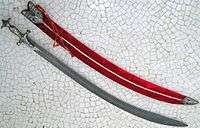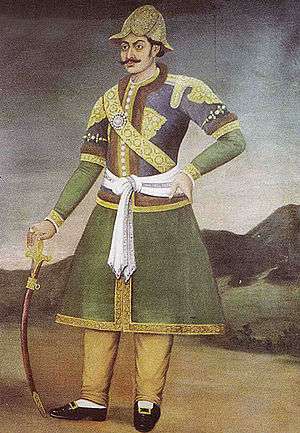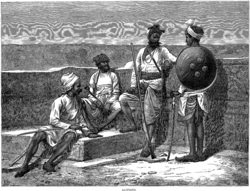Talwar
The talwar (pronounced [t̪əlʋaːr]), also spelled talwaar and tulwar, is a type of curved sword or sabre from the Indian subcontinent.[1]
| Talwar | |
|---|---|
19th-century talwar, with typical disc-hilt and knucklebow, North India, crystalline wootz steel blade unusual in having a yelmen. The hardened cutting edge has been fused (scarf welded) to a softer, more flexible heel (a common practice in Indian swords), silver koftgari decorated hilt, red velvet covered scabbard. | |
| Type | Sword |
| Place of origin | Indian Subcontinent |
| Production history | |
| Produced | Early types from c. 1300, the classic form from c. 1500 to present (particularly within Mughal India) |
| Specifications | |
| Blade type | Single-edged, curved bladed, pointed tip. |
| Hilt type | Unique Indian "disc hilt" |
| Scabbard/sheath | Leather or cloth covered wood and the same with metal mounts, all metal and leather covered metal. |
Etymology
The word talwar originated from the Sanskrit word taravāri (Sanskrit: तरवारि) which means "one-edged sword".[2]
History
The talwar originated alongside other curved swords such as the Persian shamshir, the Turkish kilij and the Afghan pulwar, all such swords being originally derived from earlier curved swords developed in Turkic Central Asia.[3] The talwar typically does not have as radical a curve as the shamshir and only a very small minority have the expanded, stepped, yelman typical of the kilij.[4][5]
Characteristics

The talwar was produced in many varieties, with different types of blades. Some blades are very unusual, from those with double-pointed tips (zulfikar) to those with massive blades (sometimes called tegha - often deemed to be executioner's swords but on little evidence). However, all such blades are curved, and the vast majority of talwars have blades more typical of a generalised sabre.[6]
Many examples of the talwar exhibit an increased curvature in the distal half of the blade, compared to the curvature nearer the hilt. Also relatively common is a widening of the blade near the tip (without the step to the back of the blade characteristic of the yelman of the kilij). The blade profile of the British Pattern 1796 light cavalry sabre is similar to some examples of the talwar, and it has been suggested that the talwar may have contributed to the design of the British sabre.[7]
A typical talwar has a wider blade than the shamshir. Late examples often had European-made blades, set into distinctive Indian-made hilts. The hilt of the typical talwar is termed a "disc hilt" from the prominent disc-shaped flange surrounding the pommel.[8] The pommel often has a short spike projecting from its centre, sometimes pierced for a cord to secure the sword to the wrist. The hilt incorporates a simple cross-guard which frequently has a slender knucklebow attached.[9] The hilt is usually entirely of iron, though brass and silver hilts are found, and is connected to the tang of the blade by a very powerful adhesive resin. More ornate examples of the talwar often show silver or gold decoration in a form called koftgari.
Use
The talwar was used by both cavalry and infantry. The grip of the talwar is cramped and the prominent disc of the pommel presses into the wrist if attempts are made to use it to cut like a conventional sabre. These features of the talwar hilt result in the hand having a very secure and rather inflexible hold on the weapon, enforcing the use of variations on the very effective "draw cut". The fact that the talwar does not have the kind of radical curve of the shamshir indicates that it could be used for thrusting as well as cutting purposes. The blades of some examples of the talwar widen towards the tip. This increases the momentum of the distal portion of the blade when used to cut; when a blow was struck by a skilled warrior, limbs could be amputated and persons decapitated.[10] The spike attached to the pommel could be used for striking the opponent in extreme close quarter circumstances when it was not always possible to use the blade. The talwar can be held with the fore finger wrapped around the lower quillon of the cross guard.
Gallery
- Talwar hilt without knuckle bow, with extensive silver koftgari decoration.
 Talwar hilt with knuckle bow, 19th century, silver koftgari decoration, damascus steel blade.
Talwar hilt with knuckle bow, 19th century, silver koftgari decoration, damascus steel blade. Talwar, 19th century, 23 inch long blade, typical style steel handle finely decorated with silver koftgari inlay work.
Talwar, 19th century, 23 inch long blade, typical style steel handle finely decorated with silver koftgari inlay work. Mukhtiyar of Nepal holding a Talwar
Mukhtiyar of Nepal holding a Talwar Rajput soldiers holding talwars, from a series in the Illustrated London News celebrating the Royal Visit to India in early 1876.
Rajput soldiers holding talwars, from a series in the Illustrated London News celebrating the Royal Visit to India in early 1876. Indian warriors fighting with talwars, 17th century.
Indian warriors fighting with talwars, 17th century.- An Indian prince with talwar in the 1870s
 Indian soldier holding a talwar, 1850.
Indian soldier holding a talwar, 1850.
Notes
- Swords and Hilt Weapons. London: Prion. 2012. ISBN 9781853758829.
- Talwar
- Nicolle, p. 175
- Bull, p. 176
- Stone, Fig. 770. The illustration shows 6 talwar, only 1 of which has a Turkish-style yelman.
- Stone, see entries Talwar and Tegha (the glossary is alphabetical).
- Robson, p.23
- Evangelista and Gaugler, p. 575
- Evangelista and Gaugler, p. 575
- Nolan, Louis. Cavalry: its History and Tactics (Bosworth 1853, Pallas Armata facsimile reprint 1995)
References
- Bull, Stephen. An Historical Guide to Arms and Armour. London: Studio Editions, 1991. ISBN 1-85170-723-9
- Evangelista, N. and Gaugler, W.M. (1995) The encyclopedia of the sword. Greenwood Publishing Group. ISBN 0-313-27896-2
- Nicolle, D. (2007) Crusader Warfare: Muslims, Mongols and the struggle against the Crusades. Hambledon Continuum. ISBN 1-84725-146-3, ISBN 978-1-84725-146-6
- Robson, B. (1975) Swords of the British Army, Arms and Armour Press.
- Stone, G.C. (1934) A Glossary of the Construction, Decoration and Use of Arms and Armor, Southworth Press, Portland Maine.
Further reading
- Haider, Syed Zafar (1991) Islamic arms and armour of Muslim India, Bahadur Publishers.
